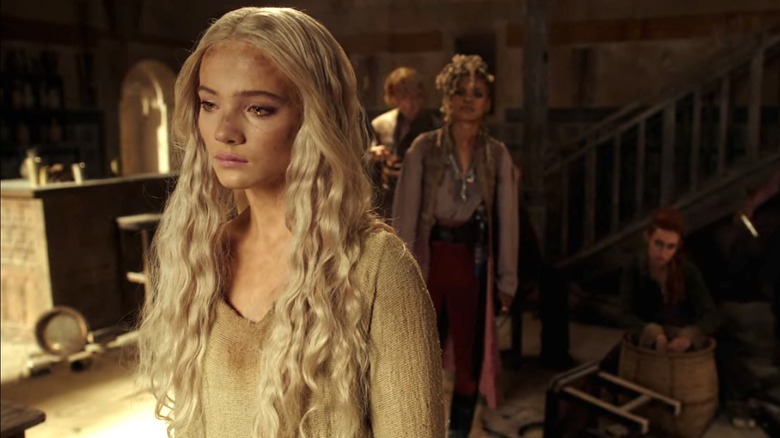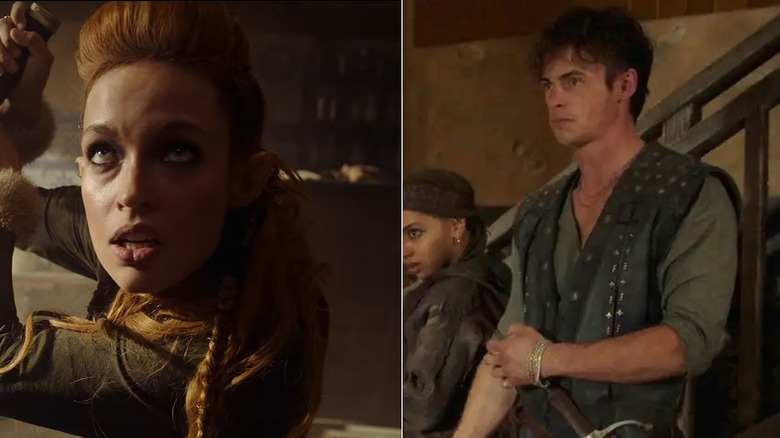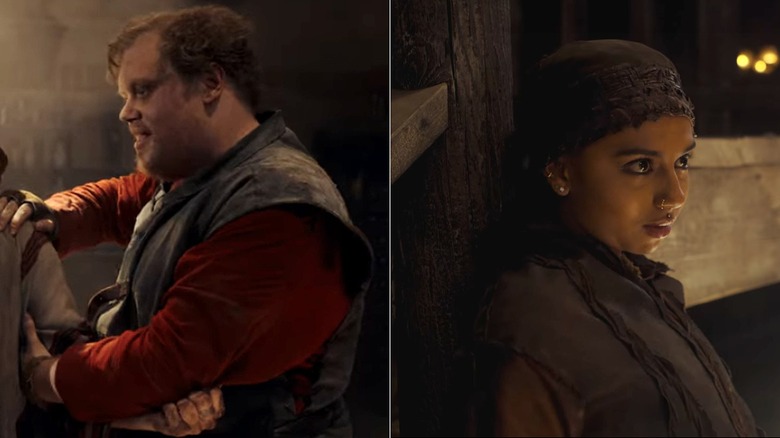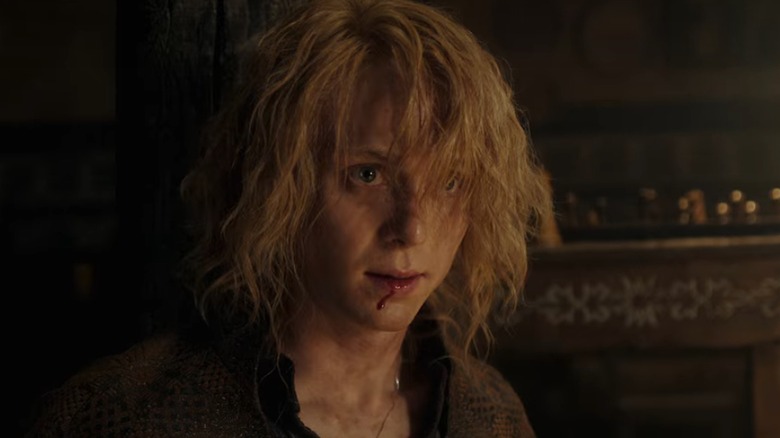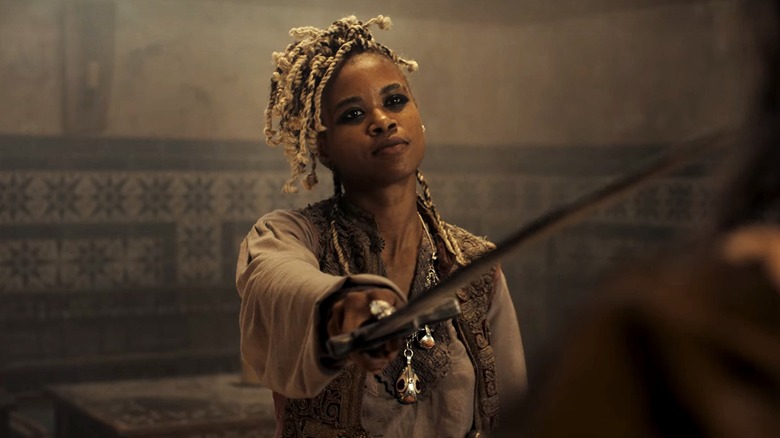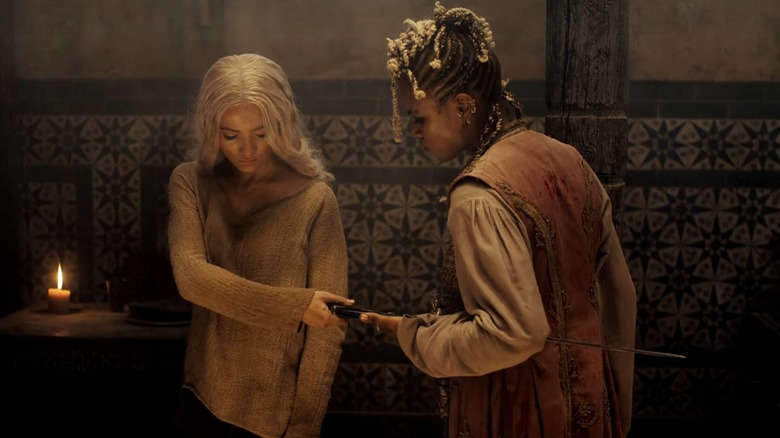The Witcher Season 4: Introducing Each Of The Rats
If one were to throw Al Capone, Robin Hood, S. E. Hinton's Greasers, Butch Cassidy's Wild Bunch, and both the Lost Boys and pirates from Stephen Spielberg's "Hook" into a literary food processor, add a harsh dose of reality, and hit "blend," the result would be something akin to the Rats of Andrzej Sapkowski's "The Witcher" series. Caught somewhere between anti-heroes and sympathetic-if-frequently-ignoble villains, the six delinquents are defined as much by their youth, loyalty to one another, tragic and traumatic backstories, and a questionable but consistent code of conduct as they are by their violence, arrogance, and blunted appreciation of right and wrong. After the Thanedd coup, the Rats provide Ciri with a surrogate family and a simple enough kill or be killed worldview that appeals to her pain and helplessness. And although, in her time with them, Ciri embraces the darkest aspects of her being, it's difficult to hold the Rats entirely accountable for some of their more despicable acts or for acting immoral and treacherous in response to an immoral and treacherous world.
In "Time of Contempt," Sapkowski describes the sextet as "a strange, mixed bag created by war, misfortune, and contempt" (p. 325). Each of them has this and more in common with Ciri, and represents a different, often exaggerated or distilled facet of her being, as well as a potential image of what she might become sans Geralt and Yennefer's guidance and protection. In Netflix's "The Witcher," audiences first properly meet the Rats (with whom Freya Allan's Ciri goes by "Falka") in Season 3's "The Cost of Chaos," but it will be Season 4 that dives most thoroughly into her formative — and ultimately unfortunate — experiences with the gang. While we await the distant future, here's a glance at the fiery personalities that consume Ciri's post-Frying Pan journey.
Giselher & Iskra: the captain and the child of fire
Like many of the Continent's youth, Giselher's story begins with his being forced to fight — and likely die — for a cause beyond his comprehension, control, or benefit. After being press-ganged into and quickly deserting an army, he kept to himself in the forest before teaming up with his first gang. When that first crew was ambushed and demolished by a group of forest elves, Giselher, the sole survivor, found himself pinned to a tree by an arrow. And that's when Iskra, an elf who'd been condemned to banishment, came into the picture.
"The next morning," Sapkowski writes, "the one who pulled the arrow and dressed his wound was Aenyeweddien [...but] her name, meaning 'Child of the Fire' in loose translation, was too difficult and too poetic for Giselher. He called her Iskra" ("Time of Contempt," p. 326). Giselher's innate street smarts and penchant for ensuring cooler (or at least cleverer) heads prevail make him a natural leader, and it's not hard to draw comparisons between him and the kind of fighter Ciri wanted to be during her time at Kaer Morhen.
Meanwhile, the ostentatious Iskra is by far the most suspicious of Ciri, and initially competitive with the Rats' newest recruit. This is hardly surprising given what Iskra represents with regard to who Ciri is. It's no accident that Iskra's real name means "child of fire," and that the name Ciri gives them — Falka — belongs to a legendary elf who was burned at the stake, and plays a key role in Ciri's elder blood lineage and potential for destruction. Giselher and Iskra are a "foilship" of a dynamic duo, and each of them symbolizes a direction in which Ciri could take her skill, experience, and untapped potential for violence.
Asse and Reef: the blacksmith's son and the Nilfgaardian
Before they were a group of six, the Rats were three separate duos, with each pair made up of a rescuer and rescuee. Just as Iskra saved Giselher, Asse — the son of a blacksmith who's described repeatedly as "broad-shouldered" — saved Mistle, who'd been thrown into a ditch and left to die by her captors (child traffickers) when Asse found her.
Asse witnessed the Nilfgaardians slaughter his entire family, and his thirst for vengeance mirrors Ciri's after losing her own family to the black-armored soldiers in Cintra. Though we don't learn much more about his origins, Asse's brief introduction is representative of what first drew the Rats together and what binds them together while all other gangs fall apart. Each of the Rats was left alone in the wake of a violent trauma, and since they weren't much more than children, they took two things from this: anger and a need for something, or someone (meaning anyone), to cling to. This need is what saved Reef, a former Nilfgaardian soldier.
Following a Nilfgaardian attack on his rebel stronghold — and while crawling across a yard riddled with corpses — the sixteen-year-old Kayleigh stumbled across Reef, who'd been abandoned by his army and left to die after being injured. Instead of killing his dying enemy, Kayleigh, who didn't want to be alone, chose to save him. Reef has no love for Nilfgaard or its cause, but his early interactions with Ciri suggest he's held on to more empathy than some of the others. When Giselher begins asking her questions about who she is and where she's from, Reef defends her silence, since he'd once felt the need to be similarly tight-lipped about his Nilfgaardian background.
Kayleigh: too far gone
While living in the rebel holdout in Ebbing, we're told, "Kayleigh had woken up in smoke, fire and blood" (p. 325). It's a scene straight out of the fall of Cintra that Ciri survived (in "The Witcher" timeline, just a few years prior) and that haunts the princess's dreams in the immediate aftermath of her escape. (See: the fiery nightmare that opens "The Blood of Elves.") It's also a scene that fills the young Kayleigh with the kind of contempt, malice, and disillusion with humanity that turns to numbness and can't be healed. During Ciri's first night with the Rats, Kayleigh attempts to force himself on her, and later, he laughingly threatens similar predation on a young girl despite the fact that the Rats don't harm women or children. The latter exchange takes place in "Baptism of Fire," and, relevantly, Ciri comes close to mimicking Kayleigh's behavior in the same interaction. "What are you waiting for?" she asks the girl, who's refusing to hand over a fancy unicorn brooch — "should I tear it off along with the bodice?" (pp. 259-260).
The more time Ciri spends as Falka, the more she begins to act — as Kayleigh acts — like someone entirely devoid of human emotion or understanding. Particularly in his vulturous interaction with the newly-inducted Ciri, one gets the distinct impression that Kayleigh lacks the internal compass necessary to even give his actions a pro-active intent. It's almost as if, having lived for so long like an animal, he's lost his grasp on what it means to be human. Thankfully, before Kayleigh is able to get very far in his attempted abuse of Ciri (which isn't to say he left her unharmed), Mistle steps in, threatens his life, and scares him off.
Mistle: the cycle of trauma
Unfortunately, Mistle then proceeds to coerce Ciri — who, after nearly being raped, is in absolutely no position to give consent — into reluctantly acquiescing to her own sexual advances. The scene is a point of frequent debate for readers. While many feel Mistle's actions are no different from Kayleigh's (as seen in several Reddit threads), others insist that whatever our interpretation of the scene may be, Sapkowski "couldn't" have intended it to be read as a rape, since Ciri and Mistle become a couple (as discussed in this Reddit thread). Given Sapkowski's thematic focus on bodily autonomy and his penchant for exploring trauma and response, it's unlikely readers are interpreting something he "didn't intend." The plain reality is that it's not uncommon for human beings to victimize those they supposedly love, or for those who've been victimized to give their love to someone who's hurt them. And when one or both of those humans has/have survived the kind of profound trauma that Mistle and Ciri have, the end result is a relationship marred by denial, self-conflict, and pain. That Sapkowski is not afraid to examine such a relationship is one of the novels' strengths, though it hardly makes for an easy or straightforward interpretation and adaptation.
We know quite a bit more about Mistle's trauma than the rest of the Rats'. Like Ciri, Mistle came from wealth and was separated from her family during the chaos of war. Unlike Ciri, Mistle didn't manage to escape to (relative) safety. Instead, she fell into the hands of manhunters trafficking girls younger than 17, and then into the hands of Nilfgaardians, who proceeded to rape her and the other girls before tossing them into the ditch from which Asse ultimately pulled Mistle, the lone survivor ("Time of Contempt," pp. 326-327).
Netflix has some decisions to make
Though Mistle sees herself as Ciri's lover and protector, her lack of understanding about what a healthy relationship is causes her to be possessive. In "Baptism of Fire," Ciri grows openly resentful of the relationship, and when Mistle says "why you don't leave, if being with me is so awful?" Ciri responds, "I don't want to be alone" (p. 238).
This is what it comes down to for all of the Rats, ultimately.
In a more traditional fairytale, the colorfully adorned teen outlaws who simultaneously terrorize and share their bounty with the peasants of each village they pass (so as to earn their respect and buy their silence) would be little more than hip, mini gangsters playing guns and robbers. But Sapkowski's Rats are more complicated than that. Even their dramatic, subversive version of The Pentecostal Oath is more sorrowful and heartbreaking than admirable or noble. The chaos, arbitrary violence, and gutting injustice of war stole their childhoods, and it's their fear, rage, loss, and trauma that bonds them together — not love, not friendship, and certainly not some affinity for freedom, family, and thumbing one's nose at authority or oppression.
Sapkowski doesn't shy away from the psychological cost of the atrocities of war, and in Season 4, Netflix writers will have to decide if their adaptation has the time, capacity, and courage to give the Rats' story — and all that their deeply tragic co-dependance represents and speaks to — the dimension, gravity, and meaningful and thorough exploration it demands.
If you or anyone you know has been a victim of sexual assault, help is available. Visit the Rape, Abuse & Incest National Network website or contact RAINN's National Helpline at 1-800-656-HOPE (4673)
